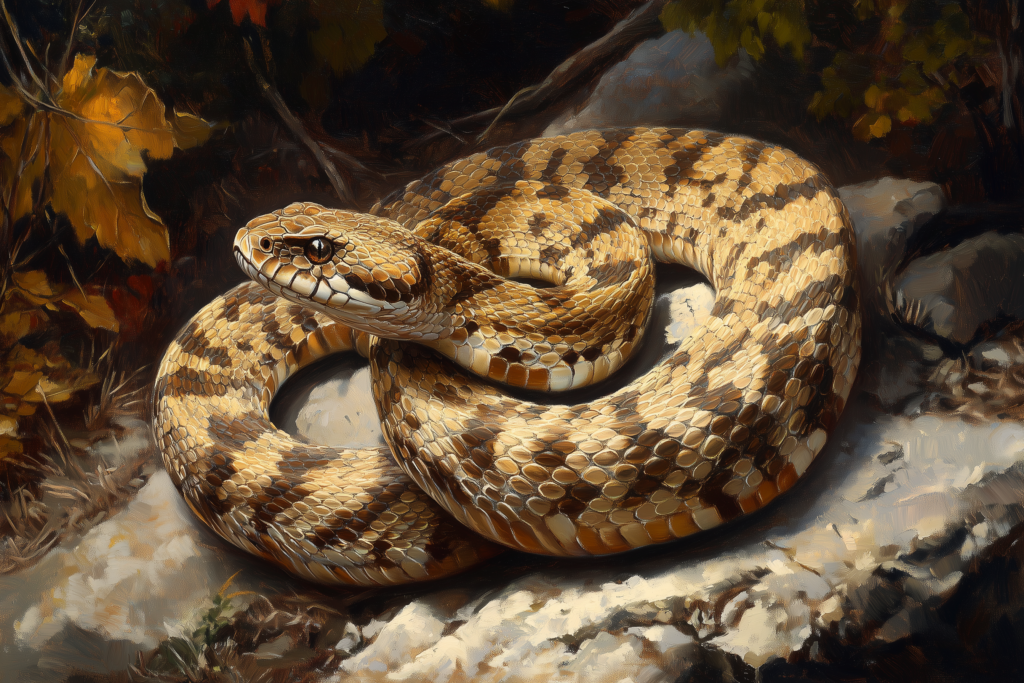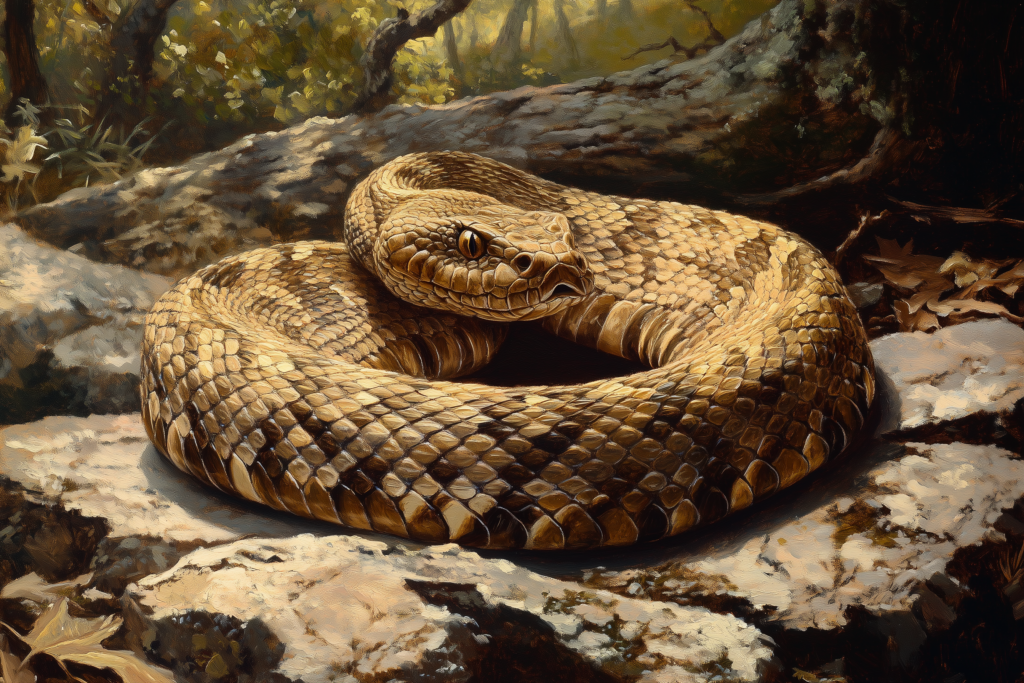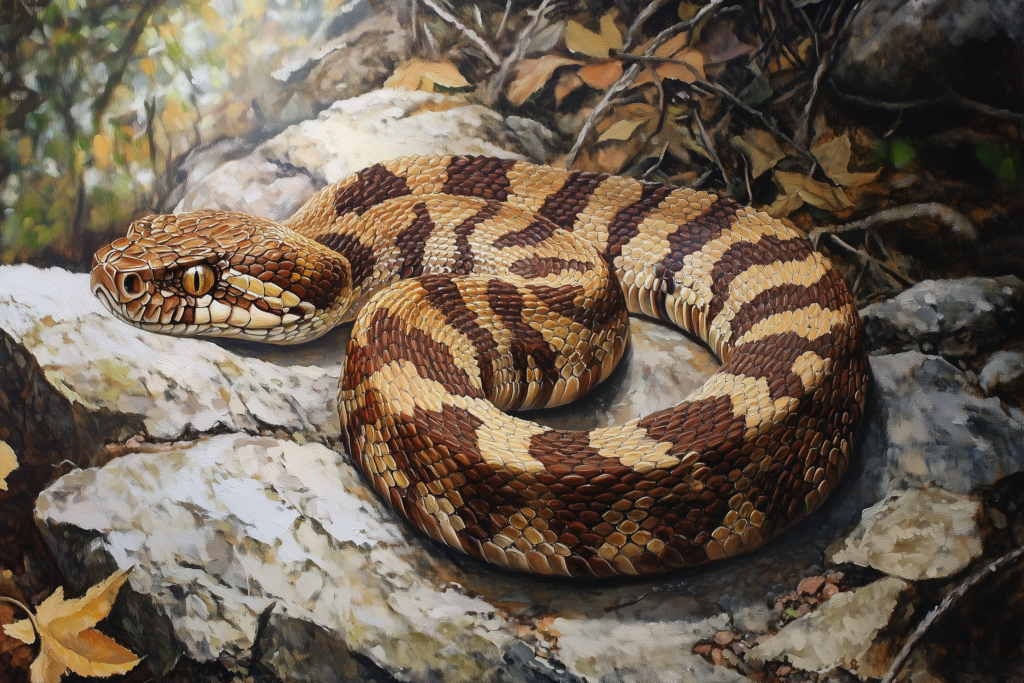Viper Snake, “The Silent Watchers”
“Discover the deadly secrets of the Viper snake – venomous fangs, lightning strikes, and survival instincts that will leave you breathless!”

The Viper snake is a venomous predator known for its distinctive triangular head and long, retractable fangs. Its appearance varies greatly depending on the species, but it typically features thick, stocky bodies with patterned scales, often in shades of brown, grey, or green, providing excellent camouflage. Some vipers, like the Gaboon viper, possess large, exaggerated heads and impressive, large fangs, while others, such as the rattlesnake, are known for their characteristic rattles at the tail.
Vipers are solitary creatures, primarily active during the night (nocturnal) or in the early morning. They are ambush predators, relying on their camouflage and stillness to wait for prey, such as rodents or birds, to come within striking distance. When prey approaches, vipers use a lightning-fast strike, injecting venom through their hollow fangs, paralyzing or killing their prey. Their venom is a potent cocktail of hemotoxins, which cause tissue destruction and immobilize prey, making it easier for the snake to consume.
Vipers are found in a wide range of habitats, including forests, deserts, grasslands, and rocky areas. Some species, such as the pit vipers, also use heat-sensitive pits to detect warm-blooded prey in darkness. They often hide in crevices, under rocks, or in dense foliage, making them hard to detect by both predators and prey.
Their primary motivation is survival through hunting and reproduction. They are opportunistic feeders, often waiting for prey to come to them rather than actively hunting. In moments of danger, vipers may hiss loudly, raise their heads in warning, or strike in self-defense, but they generally prefer to avoid confrontation.
Viper Snake 5e
Viper Snake Pathfinder
Viper Snake

Small Beast, Unaligned
Armor Class 14 (natural armor)
Hit Points 22 (5d6 + 5)
Speed 30 ft.
| STR | DEX | CON | INT | WIS | CHA |
|---|---|---|---|---|---|
| 12 (+1) | 16 (+3) | 12 (+1) | 2 (-4) | 14 (+2) | 6 (-2) |
Skills Stealth +5, Perception +4
Senses Blindsight 10 ft., Darkvision 30 ft., Passive Perception 14
Languages —
Challenge 1 (200 XP)
Traits
- Keen Smell: It has advantage on Wisdom (Perception) checks that rely on smell. It can detect prey from a considerable distance, even if it’s hiding or hidden from sight.
- Venomous Bite: It’s bite delivers a deadly dose of venom. The bite deals 4 (1d6 + 1) piercing damage, plus 7 (2d6) poison damage. The target must succeed on a DC 12 Constitution saving throw or become poisoned for 1 minute. While poisoned in this way, the target takes 5 (1d10) poison damage at the start of each of its turns. A creature can repeat the saving throw at the end of each of its turns, ending the effect on itself on a success.
- Camouflage: The viper snake has advantage on Dexterity (Stealth) checks made to hide in natural terrain, such as rocky areas, dense foliage, or underbrush. It can blend into its surroundings easily and remain undetected unless the creature is actively searching for it.
Actions
- Bite:
Melee Weapon Attack: +5 to hit, reach 5 ft., one target.
Hit: 4 (1d6 + 1) piercing damage, plus 7 (2d6) poison damage.
Tactics & Behavior
- Ambush Specialist: The viper snake is a stealthy predator that excels at lying in wait. It uses its Camouflage to stay hidden and ambush prey that comes too close. It is patient, often waiting for several minutes or even hours before striking.
- Venom Over Strength: The viper snake relies on its venom to incapacitate prey. It bites quickly and efficiently, injecting poison that weakens its target. Once it strikes, it retreats into the environment to observe its prey’s reaction.
- Silent and Patient: The snake doesn’t rush or waste energy. If it is disturbed or misses its target, it will often retreat to wait for another opportunity rather than pressing the attack. It is a patient hunter, preferring to let its venom work rather than engage in prolonged combat.
Environment & Mood
Viper snakes are typically found in rocky hills, dense forests, or deserts, where they can use natural terrain to conceal themselves. The mood around the viper snake is one of quiet danger. It is often difficult to detect until it strikes. Its environment is calm and still, reflecting the patient nature of the snake. When threatened or cornered, however, it strikes swiftly and decisively.
Combat Example
The viper snake is an expert ambush predator, and it will hide in natural surroundings, waiting for prey to come within range. It strikes with its Bite, using its venom to incapacitate the creature. After a successful strike, it will retreat into its hiding spot to observe the prey’s reaction, waiting for another chance to strike once the creature is weakened. If the viper misses or is disturbed, it will slither away quietly to find a safer position.
Viper Snake

Viper CR 1/2
XP 200
N Tiny animal
Init +3; Senses low-light vision, scent; Perception +9
DEFENSE
AC 16, touch 15, flat-footed 13 (+3 Dex, +1 natural, +2 size)
hp 3 (1d8–1)
Fort +1, Ref +5, Will +1
OFFENSE
Speed 20 ft., climb 20 ft., swim 20 ft.
Melee bite +5 (1d2–2 plus poison)
Space 2-1/2 ft.; Reach 0 ft.
STATISTICS
Str 4, Dex 17, Con 8, Int 1, Wis 13, Cha 2
Base Atk +0; CMB +1; CMD 8 (can’t be tripped)
Feats Weapon Finesse
Skills Climb +11, Perception +9, Stealth +15, Swim +11; Racial Modifiers +4 Perception, +4 Stealth
SPECIAL ABILITIES
Poison (Ex)
Bite—injury; save Fort DC 9; frequency 1/round for 6 rounds; effect 1d2 Con damage; cure 1 save.
ECOLOGY
Environment any temperate and warm
Organization solitary
Treasure none
Vipers are not particularly aggressive snakes, but their poisonous bite can be deadly.

 Buy me a coffee
Buy me a coffee